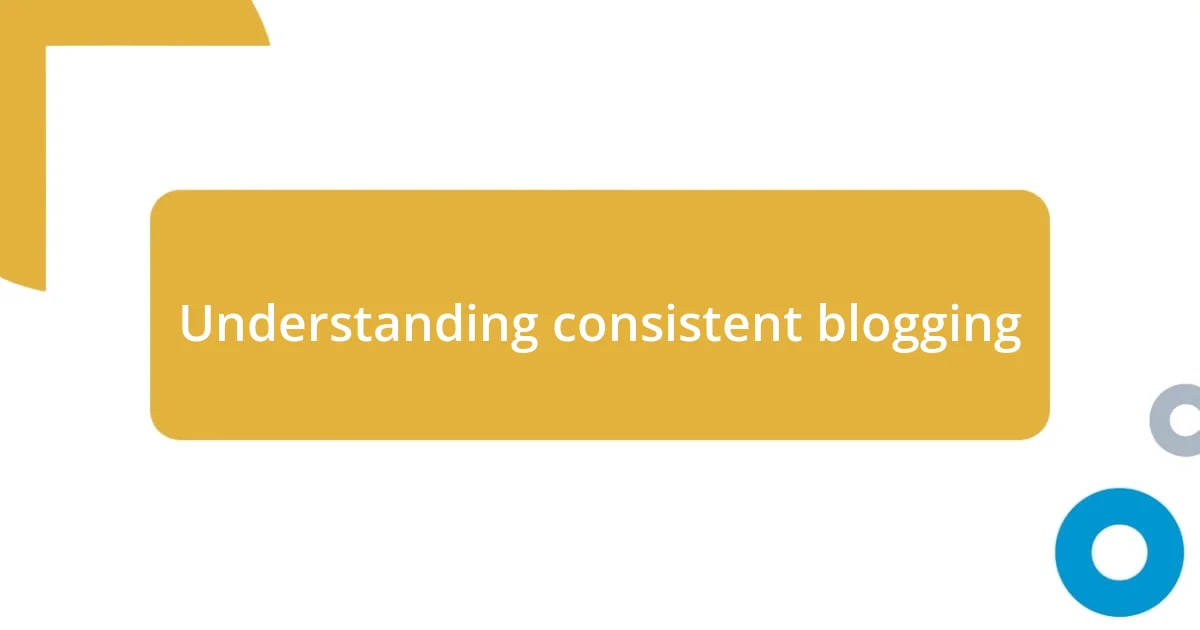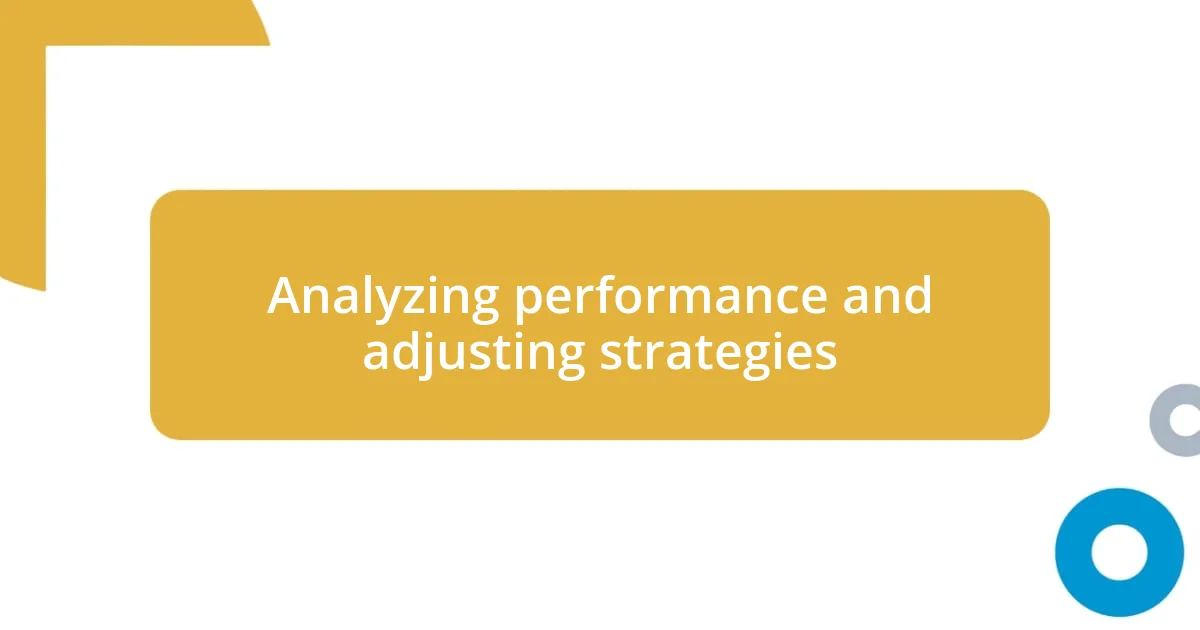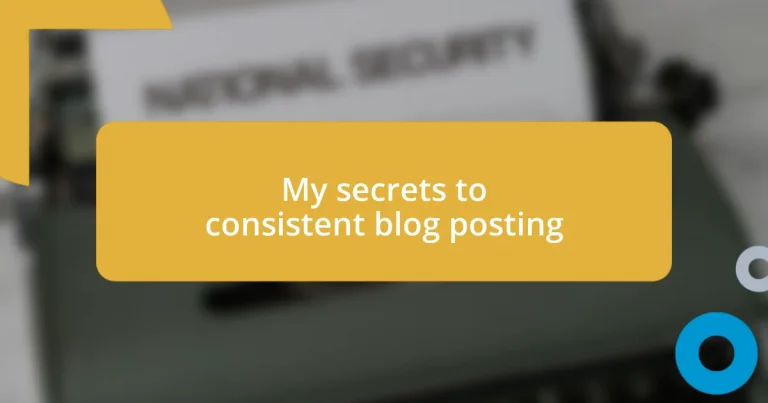Key takeaways:
- Consistency in blogging is crucial for building trust and engagement with readers; establishing a regular posting schedule enhances creativity and connection.
- Setting clear blogging goals, such as post frequency and engagement targets, provides direction and purpose, helping bloggers maintain focus and passion.
- Utilizing tools like content calendars and automation for social media sharing can significantly improve efficiency, allowing bloggers to concentrate on creating quality content.

Understanding consistent blogging
When I first started blogging, I found that consistency was as important as the content itself. I remember posting sporadically and feeling frustrated when my audience didn’t grow. This taught me that showing up regularly builds trust with readers; they want to know they can rely on you.
Isn’t it interesting how a steady rhythm of posts can transform a blog? I’ve noticed that when I commit to a schedule, my creativity thrives. It’s almost like setting a date to meet with a good friend; it motivates you to prepare and share something meaningful each time.
Moreover, consistent blogging isn’t just about frequency; it’s about nurturing your unique voice. I’ve embraced the idea that each post is a conversation, not just a publication. This perspective shift not only makes writing enjoyable but also encourages my readers to engage more actively. How has your blogging journey shaped your own understanding of consistency?

Setting clear blogging goals
Setting clear blogging goals is a game-changer in maintaining consistency. I recall one hectic season when I realized that my posts lacked direction. I took a step back and started to outline specific goals for my blog. This not only clarified my focus but also reignited my passion for writing. Without goals, I often felt lost, but defining targeted objectives made me feel more grounded and purposeful.
Here are a few key goals I recommend considering for your blog:
- Post Frequency: Decide how often you want to publish (e.g., weekly, bi-weekly).
- Content Themes: Identify core themes or topics to stick to, ensuring your audience knows what to expect.
- Engagement Targets: Set goals for reader interactions, like comments or social media shares.
- SEO Objectives: Aim for specific keywords or search rankings to improve visibility and reach.
- Skill Development: Focus on improving writing skills or learning new blogging tools along the way.

Creating a reliable content calendar
Creating a reliable content calendar is something I’ve grown to appreciate over time. When I first attempted to plan my posts, I struggled with vague ideas and hurried scribbles on scraps of paper. It felt chaotic and, honestly, overwhelming. Eventually, I shifted to a structured calendar where I map out content weeks, sometimes even months in advance. This not only helps me keep track of what needs to be done but also alleviates the anxiety of last-minute writing. How many times have you found a looming deadline pushing you to create something rushed? Having a clear calendar alleviates that pressure, allowing for more thoughtful content.
I’ve learned that consistency thrives on predictability, and nothing makes that clearer than a well-organized content calendar. A few months ago, I planned an entire series based on reader requests, which completely transformed my approach. What I didn’t expect was how much fun it would be to see those ideas unfold over several weeks! Having each topic plotted out made it feel like less of a chore and more of a creative journey. I genuinely believe that when you allocate time for each post, you cultivate a stronger relationship with your readers. Which topics resonate most with your audience?
To create a solid content calendar, I recommend including elements like titles, deadlines, and keywords to focus your posts. For instance, I often jot down potential headlines alongside my publication dates to see how they flow together. As I reflect on this process, I realize how crucial that visibility is—it’s like having a roadmap that guides my creativity.
| Content Calendar Element | Description |
|---|---|
| Post Titles | Catchy headlines to draw readers in. |
| Publication Dates | Deadlines to keep yourself accountable. |
| Keywords | Targeted phrases to enhance SEO. |

Finding inspiration for blog topics
Finding inspiration for blog topics often feels like a hunt—but one that can be exhilarating. I remember sitting in a café once, quietly sipping my coffee, when a simple conversation at a nearby table sparked a post idea about communication in relationships. This moment taught me that inspiration can emerge from everyday life. So, don’t shy away from observing your surroundings; you might be surprised by what catches your attention.
One trick I regularly use is to keep an idea journal. I jot down anything that resonates with me: snippets from conversations, intriguing articles, or even personal reflections. Just the other day, I found a gem of a topic while browsing through social media—an ongoing debate that left me pondering. What if you took a few moments every day to reflect on what inspired you? This practice not only helps build a reservoir of ideas but also allows you to connect more deeply with your writing.
Sometimes, I also rely on audience engagement to spark new topics. I regularly ask my readers what they want to know—this not only makes my content more relevant but also strengthens my connection with them. A few weeks ago, a reader requested a deep dive into productivity hacks. It prompted me to explore new methods I had been using, leading to a post that resonated widely. Isn’t it fascinating how our audience can help guide our creative journey? Engaging with your readers in this way can turn their needs into your next blog post.

Establishing a writing routine
Establishing a writing routine is crucial for maintaining consistency and fostering productivity. I find that setting aside dedicated time each day, even if it’s just 30 minutes, can lead to remarkable progress. One weekend morning, I committed to waking up a bit earlier, and I was amazed at how much clearer my mind felt. What’s your peak creativity time? For me, it’s that still quiet moment before the day starts.
Creating a comfortable writing environment can also significantly influence my routine. I’ve arranged a cozy nook in my home with my favorite plant and a cup of herbal tea by my side. This little ritual not only prepares me mentally but also signals to my brain that it’s time for creativity. There’s comfort in this routine—it allows my thoughts to flow more freely. How do you create a space that inspires you? If yours feels chaotic, perhaps a personal sanctuary might do the trick.
Lastly, I’ve learned the value of flexibility. While routine is essential, life happens, and sometimes, I just can’t stick to my planned schedule. On those days, I allow myself to write less—perhaps just jotting down thoughts or even bullet points. It’s liberating to know that every word counts, even if it doesn’t flow like I’d originally hoped. Have you ever found that just getting something down eases the pressure? Embracing this approach has kept my passion alive, letting my writing be a joy rather than a chore.

Leveraging tools for efficiency
When it comes to enhancing efficiency in blogging, leveraging the right tools can make a world of difference. I can’t stress enough how much adopting an editorial calendar has streamlined my process. Just last month, I sat down for an afternoon and mapped out my content for the next three months. The clarity I gained from seeing everything laid out helped reduce that overwhelming feeling of uncertainty. Have you ever felt more at ease just knowing what lies ahead?
Another tool that I swear by is content management software. I remember the frustration of managing drafts scattered across multiple documents. Switching to a platform where I can organize, edit, and track my posts in one place saved me countless hours. The best part? It allows for collaboration. Sometimes I invite a friend to brainstorm with me; bouncing ideas off someone else can be refreshing. Have you tried this? Opening up your process to others can bring in fresh perspectives you might not have considered.
Lastly, automation tools have become my best friends for social media sharing. I’ve set up posts to go live at optimal times without me having to lift a finger. It’s such a relief to know that my content is being shared consistently while I focus on writing new pieces. The time I’ve saved has allowed me to dive deeper into topics that truly matter to me. What’s stopping you from automating repetitive tasks? Taking advantage of these tools can free you up to focus on what you love most: writing.

Analyzing performance and adjusting strategies
Analyzing my performance after each posting has become a game-changer for my blogging journey. I remember the first time I reviewed my blog stats—seeing which topics resonated with readers and which fell flat was eye-opening. Have you ever been surprised by what your audience truly enjoys? By diving into analytics, I can pinpoint trends and adjust my strategy accordingly, ensuring that my content evolves with my readers’ preferences.
In addition to looking at statistics, I find it essential to gather feedback from my audience. Sometimes, I’ll post a quick poll on social media, asking what they want to read next. When one of my readers suggested exploring a lesser-known topic, I had this surreal realization of how connected we could be through sharing ideas. This simple act of engagement not only helps me cater to my audience but also creates a sense of community that fuels my writing passion. Isn’t it refreshing when your readers feel involved in the creative process?
As I reflect on my blogging journey, adjusting my strategies feels more like an exciting challenge than a chore. Recently, I noticed that my writing style had grown a bit stale, so I decided to experiment with different formats like listicles and narratives. I was amazed at the response! Have you ever taken a risk in your writing that paid off unexpectedly? Embracing experimentation has not only revitalized my content but also kept my readers engaged. It’s a win-win situation, and I often find myself eager to innovate with each new post.














